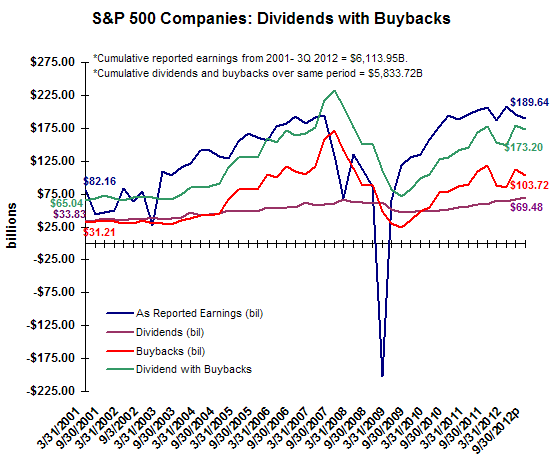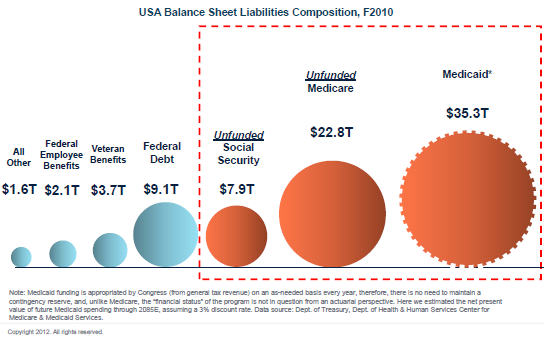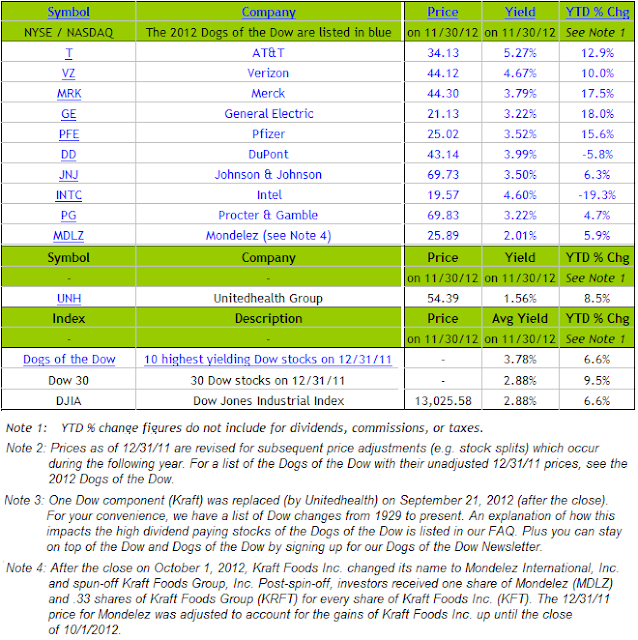Monday, December 31, 2012
Thank You To Our Clients, Prospects And Readers Of Our Content
Posted by
David Templeton, CFA
at
4:18 PM
0
comments
![]()
![]()
Labels: General Market
Volumes Near Ten Year Low
 |
| From The Blog of HORAN Capital Advisors |
 |
| From The Blog of HORAN Capital Advisors |
 |
| From The Blog of HORAN Capital Advisors |
Posted by
David Templeton, CFA
at
3:19 PM
0
comments
![]()
![]()
Labels: General Market , Technicals
Sunday, December 30, 2012
Dividend Strategies Underperform In 2012
 |
| From The Blog of HORAN Capital Advisors |
 |
| From The Blog of HORAN Capital Advisors |
 |
| From The Blog of HORAN Capital Advisors |
Posted by
David Templeton, CFA
at
5:21 PM
0
comments
![]()
![]()
Labels: Dividend Return , General Market
Dividend Growth More Consistent Than Buybacks In Q3 2012
 |
| From The Blog of HORAN Capital Advisors |
 |
| From The Blog of HORAN Capital Advisors |
Posted by
David Templeton, CFA
at
2:18 PM
0
comments
![]()
![]()
Labels: Dividend Analysis , General Market
Saturday, December 29, 2012
A Look At The Top 1% Of Taxpayers, Government Revenues/Expenses And The Deficit
 |
| From The Blog of HORAN Capital Advisors |
- "the 1.35 million taxpayers that represent the highest-earning one percent of the Americans who filed federal income tax returns in 2010 earned 18.9% of the total gross income and paid 37.4% of all federal income taxes paid in that year."
- "the 128.3 million taxpayers in the bottom 95% of all U.S. taxpayers in 2010 earned 66.2% of gross income and that group paid 40.9% of all taxes paid."
- "in other words, the top 1 percent (1.35 million) of American taxpayers paid almost as much federal income tax in 2010 ($354.8 billion) as the entire bottom 95% of American tax filers ($388.4 billion)."
- "about half (58 million) of the bottom 95% of American “taxpayers” paid nothing or got a tax refund."
 |
| From The Blog of HORAN Capital Advisors |
 |
| From The Blog of HORAN Capital Advisors |
Posted by
David Templeton, CFA
at
2:34 PM
0
comments
![]()
![]()
Labels: Economy
Wednesday, December 26, 2012
A Need To Focus On Government Outlays
 |
| From The Blog of HORAN Capital Advisors |
 |
| From The Blog of HORAN Capital Advisors |
Posted by
David Templeton, CFA
at
3:15 PM
0
comments
![]()
![]()
Labels: Economy
Saturday, December 22, 2012
Fiscal Cliff Not Resulting In Dividend Cliff
Interestingly, this potentially higher tax rate does not seem to be having a "negative" impact on the long term dividend policy for companies. Factset Research notes in their Dividend Quarterly report for Q3:
- aggregate dividends per share (“DPS”) grew 15.5% year-over-year at the end of Q3.
- the number of companies paying a dividend in the trailing twelve-month period again surpassed 400 (80% of the S&P 500 index).
- the S&P 500 also hasn’t shown a slowdown in companies initiating dividend payments. In Q3, 3.0% of non-payers “initiated” dividends, which is nearly triple the average over ten years (1.2%).
- the aggregate dividend payout ratio is 2.0% below the ten-year median, it is at its highest level (29.1% at the end of Q3) since the recession (when payout ratios were distorted by low aggregate earnings during the recession...).
- while there have been a number of companies that are signaling short-term changes in dividend policy or a shift towards more share buybacks..., a majority of companies have not yet responded, including the top ten dividend-payers in the S&P 500.
- the aggregate, forward twelve-month DPS estimate for the S&P 500 was 10% above the actual trailing twelve-month (“TTM”) payout at the end of November, which is a premium that is well above the ten-year average of 3%... Also, even when excluding the periods during the financial crisis (when forward DPS estimates fell below trailing figures), the forward consensus premium is in-line with the stabilized average starting in 2011.
Source:
Factset Dividend Quarterly (PDF)
By: Michael Amenta, Research Analyst
Facset Research
December 19, 2012
http://www.factset.com/websitefiles/PDFs/dividend/dividend_12.19.12
Factset Buyback Quarterly (PDF)
By: Michael Amenta, Research Analyst
Facset Research
December 20, 2012
http://www.factset.com/websitefiles/PDFs/buyback/buyback_12.20.12
Posted by
David Templeton, CFA
at
2:17 PM
0
comments
![]()
![]()
Labels: Dividend Analysis
Sunday, December 16, 2012
Technology Sector Largest Contributor To S&P 500 Yield
 |
| From The Blog of HORAN Capital Advisors |
 |
| From The Blog of HORAN Capital Advisors |
Data Source: Standard & Poor's
Posted by
David Templeton, CFA
at
11:24 PM
0
comments
![]()
![]()
Labels: Dividend Analysis
Monday, December 10, 2012
The Arithmetic Of Equities
"Basically I am a bond guy. I like fat coupons. And I like return of principal. But I take my bonds where I can find them. And these days the place to find fat coupons and return of principal is among blue chip equities."
h/t: Market Folly
Posted by
David Templeton, CFA
at
9:26 AM
0
comments
![]()
![]()
Labels: General Market , Valuation
Another Record In Food Stamp Usage
Posted by
David Templeton, CFA
at
3:00 AM
0
comments
![]()
![]()
Labels: Economy
Sunday, December 09, 2012
Fiscal Cliff Creating A Spike In Extra Dividends
Posted by
David Templeton, CFA
at
6:28 PM
0
comments
![]()
![]()
Labels: Dividend Analysis
Saturday, December 08, 2012
Not So Golden Retirement Years Is Fallout From Weak Friday Employment Report
- those not in the labor force rose 542,000
- the civilian labor force fell by 350,000
- the number of employed declined 122,000
- discouraged workers rose 166,000, and
- the participation rate fell two tenths of a percent to 63.6%
 |
| From The Blog of HORAN Capital Advisors |
 |
| From The Blog of HORAN Capital Advisors |
 |
| From The Blog of HORAN Capital Advisors |
Posted by
David Templeton, CFA
at
3:50 PM
0
comments
![]()
![]()
Labels: Economy
Sunday, December 02, 2012
Implications Of An Elevated Equity Risk Premium For Asset Allocation
 |
| From The Blog of HORAN Capital Advisors |
 |
| From The Blog of HORAN Capital Advisors |
 |
| From The Blog of HORAN Capital Advisors |
Posted by
David Templeton, CFA
at
5:28 PM
0
comments
![]()
![]()
Labels: Asset Allocation , Economy , General Market
Saturday, December 01, 2012
Dogs Of The Dow Performance Update
Posted by
David Templeton, CFA
at
6:33 PM
0
comments
![]()
![]()
Labels: Investments
Sunday, November 25, 2012
Retailers Open Thanksgiving To Counteract E-commerce Sales
 |
| From The Blog of HORAN Capital Advisors |
 |
| From The Blog of HORAN Capital Advisors |
Source:
Black Friday Billion: Kick-Off to Brick-and-Mortar Shopping Season
Surges Past $1 Billion in E-Commerce Spending for the First Time
comScore
November 25, 2012
http://tinyurl.com/cn9xhhf
Posted by
David Templeton, CFA
at
3:59 PM
0
comments
![]()
![]()
Saturday, November 24, 2012
A Buyback Strategy Does Outperform
 |
| From The Blog of HORAN Capital Advisors |
 |
| From The Blog of HORAN Capital Advisors |
Posted by
David Templeton, CFA
at
10:37 AM
0
comments
![]()
![]()
Labels: General Market
Friday, November 23, 2012
The Challenge: Finding A Balanced Solution To The Fiscal Cliff
 |
| From The Blog of HORAN Capital Advisors |
 |
| From The Blog of HORAN Capital Advisors |
 |
| From The Blog of HORAN Capital Advisors |
 |
| From The Blog of HORAN Capital Advisors |
H/T: The thoughts behind a portion of this article were gleaned from an article on Zero Hedge.
Posted by
David Templeton, CFA
at
5:28 PM
0
comments
![]()
![]()
Labels: Economy , General Market
Thursday, November 22, 2012
U. S. Government Spending Growth Nearly Always Positive (Updated)
 |
| From The Blog of HORAN Capital Advisors |
Posted by
David Templeton, CFA
at
9:24 AM
0
comments
![]()
![]()
Labels: Economy
Sunday, November 18, 2012
New Healthcare Law: Higher Employee Turnover And Reduced Company Stock Returns?
 |
| From The Blog of HORAN Capital Advisors |
Posted by
David Templeton, CFA
at
8:27 PM
0
comments
![]()
![]()
Labels: General Market
Many Believe Market Is Oversold So What Will Happen
- Don't Jump Off The Fiscal Cliff - Forbes
- Market Rally Soon? - Extreme Oversold Levels - MTR Investors Group
- 23 of 30 Dow Stocks Oversold - Bespoke Investment Group
- Use Dip To Buy Global Growth Stocks - Deutsche Bank's David Bianco
- Case Closed Dow Ends 2012 Near 13,500 - Zenpenny
- Dow Could Jump 1,000 Points on Fiscal Cliff Deal - Jeremy Siegel
 |
| From The Blog of HORAN Capital Advisors |
| From The Blog of HORAN Capital Advisors |
 |
| From The Blog of HORAN Capital Advisors |
Posted by
David Templeton, CFA
at
2:26 PM
0
comments
![]()
![]()
Labels: Economy , General Market , Technicals
Monday, November 12, 2012
Fiscal Cliff Tax Impact By State
 |
| From The Blog of HORAN Capital Advisors |
Posted by
David Templeton, CFA
at
9:04 PM
0
comments
![]()
![]()
Labels: Economy
Equity Put/Call Ratio On The Rise
"The equity P/C ratio tends to measure the sentiment of the individual investor by dividing put volume by call volume. At the extremes, this particular measure is a contrarian one; hence, P/C ratios above 1.0 signal overly bearish sentiment from the individual investor. This indicator's average over the last 5-years is approximately .7, indicating the individual investor has been generally mostly bullish and more active on the call volume side"
| From The Blog of HORAN Capital Advisors |
Posted by
David Templeton, CFA
at
2:51 PM
0
comments
![]()
![]()
Labels: Technicals
Saturday, November 10, 2012
QE3 Not Positive For "Risk On" Asset Class Performance
 |
| From The Blog of HORAN Capital Advisors |
 |
| From The Blog of HORAN Capital Advisors |
Posted by
David Templeton, CFA
at
9:58 AM
0
comments
![]()
![]()
Labels: Economy , General Market
Thursday, November 08, 2012
Recession Risk Rising
 |
| From The Blog of HORAN Capital Advisors |
As noted in the post, The Reformed Broker's Joshua Brown states:
"Do you see the percentages on the left side of the chart? 20% is the line in the sand. We've never hit that level and NOT had a recession. In 2006 we got close (18%?) but that particular Great Recession would be a year and half in the making. Note that we're back at that 20% line again. And I can't think of anything that keeps the leading indicators from going through it to the upside - the Fiscal Cliff stuff could only speed its ascent"
H/T: Political Calculations
Posted by
David Templeton, CFA
at
9:31 AM
0
comments
![]()
![]()
Labels: Economy
Wednesday, November 07, 2012
Election Is Over But More Uncertainty Ahead
- Mohamed El-Erian: Congratulations, Mr. President. Here's how to fix the economy.
- Kiplinger Magazine: 7 Priorities for Obama's Second Term
- CNBC: Economists' advice for Obama: Avoid 'fiscal cliff'
Posted by
David Templeton, CFA
at
11:05 PM
0
comments
![]()
![]()
Labels: Economy , General Market
Saturday, November 03, 2012
Job Creation Versus Growth In Food Stamp Rolls
 |
| From The Blog of HORAN Capital Advisors |
As noted in a recent Weekly Standard article:
- "In January 2009, there were 133.56 million Americans with jobs and 31.98 million on food stamps. Today, there are 133.76 million Americans with jobs and 46.68 million on food stamps. The employment rolls have thus grown by 0.15 percent and the food stamp rolls have grown by 46 percent, meaning that for every one American who found a job, 75 Americans signed up for food stamps.
- Total spending on food stamps is now more than $80 billion annually, a fourfold increase from 2001. Total spending on federal means-tested welfare—food stamps, public housing, social services, cash aid, etc.—is now approximately $1 trillion. That amount is enough, if converted to cash, to send every household beneath the federal poverty line an annual check for $60,000."
Posted by
David Templeton, CFA
at
11:50 AM
0
comments
![]()
![]()
Labels: Economy
Thursday, November 01, 2012
U.S. Federal Budget At Critical Juncture
- Expenses exceed revenue.
- Unfunded liabilities.
 |
| From The Blog of HORAN Capital Advisors |
- Percentage of tax payers versus those receiving government benefits.
 |
| From The Blog of HORAN Capital Advisors |
The entire USA, Inc presentation is a worthwhile and eyeopening read.
h/t: Dealbook: New York Times
Posted by
David Templeton, CFA
at
10:51 AM
0
comments
![]()
![]()
Labels: Economy , General Market
Sunday, October 28, 2012
Apple: Anticipated Future Price Action
"10-28-12: The best case scenario with AAPL going forward is a period of sideways chop. Those highs at $700 won't be challenged for some time. The low created on Friday will likely be broken within the next few weeks, following a move up to $630 - $640 to convince the convincible that the iPhone 6 & 7 mean a $1,000 stock price in the near future.
The path that AAPL is likely to take has been revealed in the not to distant past. Check out box A. A high volume reversal that resulted in a gap and eventual failure.
While I don't expect a gap up here, I expect a retrace of a portion of the recent losses that should give AAPL enough new blood to make heads roll in the weeks ahead.
$520 - $550 remain the likely target for a solid buy point."
 |
| From The Blog of HORAN Capital Advisors |
Posted by
David Templeton, CFA
at
3:39 PM
0
comments
![]()
![]()
Labels: Technicals
HORAN Begins Financial Planning Blog
A few days ago, HORAN's Director of Financial Planning, Michael Napier, joined the blogosphere by starting HORAN's financial planning blog. As Michael notes in his initial post,
"Everybody blogs. In fact, it is estimated that close to 44 million blogs are created each year. Doing the math, that is nearly one new blog per second! So why am I jumping into the blogosphere? To help you get one step closer to achieving your financial goals in easy-to-understand language.
Two of the biggest challenges facing Americans today are access to great health care and the discipline to sustain wealth management strategies such as making smart decisions about investing and wealth transfer. My focus will primarily be sharing topics I come across on a daily basis to help your financial life. Strategies in tax- savings, estate planning, college savings, budgeting, insurance and retirement will be discussed."
- A Little- Known Financial Planning Strategy
- Financial Planning Must Do: Check and Double-Check Your Beneficiary Designations
The RSS Feed for all of the HORAN blogs can be found here: HORAN RSS Blog Feed
Posted by
David Templeton, CFA
at
12:44 PM
0
comments
![]()
![]()
Labels: Financial Planning
P/E Level For S&P 500 Index At Level Not Seen Since 1990s
"[The] chart illustrates the price to earnings ratio (PE ratio) from 1900 to present. Generally speaking, when the PE ratio is high, stocks are considered to be expensive. When the PE ratio is low, stocks are considered to be inexpensive. From 1900 into the mid-1990s, the PE ratio tended to peak in the low to mid-20s (red line) and trough somewhere around seven (green line). The price investors were willing to pay for a dollar of earnings increased during the dot-com boom (late 1990s), surged even higher during the dot-com bust (early 2000s), and spiked to extraordinary levels during the financial crisis (late 2000s). Since the early 2000s, the PE ratio has been trending lower with the very significant but relatively brief exception that was the financial crisis. More recently, the PE ratio has moved slightly higher. It is worth noting, however, that even with this recent uptick, the PE ratio still remains at a level not often seen since 1990."
 |
| From The Blog of HORAN Capital Advisors |
Posted by
David Templeton, CFA
at
3:00 AM
0
comments
![]()
![]()
Labels: General Market






